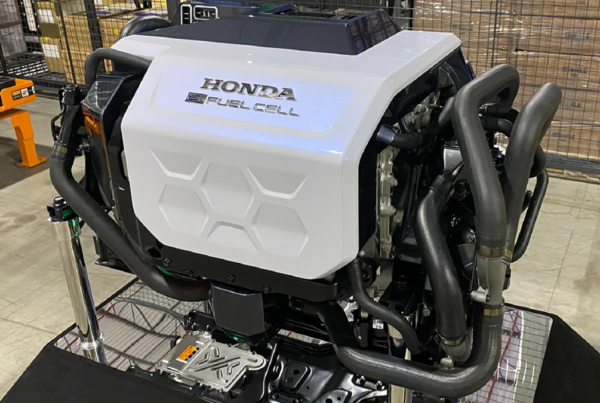
Perth-based Long Pipes Limited has devised revolutionary technology that could dramatically lower the cost of piped hydrogen.
The company is developing continuous, high-pressure composite pipes that can be constructed in the field in sections of up to 6 kms without a joint. This removes the need for steel welding. It also reduces the number of construction workers that are needed on site.
The new technology means Long Pipes can quickly install new hydrogen and ‘raw’ carbon dioxide (CO2) networks. The company calls the concept, ’Fluid Highways’.
‘We are currently working with major, global energy companies to reduce the cost of transporting hydrogen and raw CO2,’ says Executive Chairman, Neil Graham. ‘This includes projects in remote Western Australia, and discussions in Germany and France for projects in Europe and the North Sea.’
Patented hydrogen pipe technology
Long Pipes was founded in Western Australia in 2008. The company has 5 ‘new-field’ and 80 regular patents in 70 countries for the technology behind its continuous pipes.
The company has devised novel, high-pressure, corrosion-resistant, composite pipes. These pipes are simultaneously light and tough. What makes them unique, however, is that the pipe-production machinery can be mounted on trailers in the field. This means finished pipes are laid directly into trenches or along the right of way (ROW) at design speeds of up to 6km per day onshore or 30 km per day offshore.

The Long Pipes rig can lay a continuous, composite pipe up to 6 km in length.
The process is physically straightforward. Vehicle-mounted machinery inflates a pre-made, composite sock into a circular tube. Resin is injected and the tube inflated in a continuous process. Pipes harden within 2–3 hours. Then the pipe is laid in a trench.
‘We are globally unique,’ says Ulrich Hartig, Corporate Adviser, Europe. ‘We are the only makers of continuous thermo-plastic, lined, composite-reinforced pipes in the world that are also made in the field.’
Lowering the cost of hydrogen networks
This innovation in low-cost hydrogen and CO2 networks arrives at a critical point for renewable energy.
Recent forecasts from European industry suggests 40,000 kms of natural gas pipeline could be repurposed for hydrogen by 2040. But Graham says the hydrogen industry needs new pipes and storage – for multiple reasons.
‘Traditional pipelines create challenges and so do traditional technologies,’ he says. ‘Hydrogen- embrittlement corrosion can cause high-pressure, 100 bar-plus steel pipes to rupture at some point, if they are used for pure hydrogen.
‘Besides, traditional piping isn’t ideal for transition fuels. It’s currently expensive to scrub CO2 until it’s clean enough to transport in steel pipes. Our Fluid Highways concept is designed to cope with the acids and other contaminants that are present in raw CO2. This can deliver massive savings in capital expenditure and operating expenditure, based on studies by our customers.’
Faster roll-out of new hydrogen infrastructure
Graham believes that his company’s technology will change the cost-calculus for hydrogen in three ways. First, hydrogen pipe networks will be cheaper to lay down. Second, they can be laid down much more quickly than traditional steel pipes.
Third, the company’s ‘Fluid Highways’ are designed to follow power line ROWs, as they are not conducive to lighting strikes.
‘With our international energy customer, we are currently working on demonstrating that we can create a CO₂ Fluid Highway, and then set out how we can lay down 30km of pipeline per day offshore,’ he says.
There’s another factor at work – tensile strength. The company’s 250–900 mm pipes are extremely tough. This means they can be designed to take operating pressures up to 100 bar, or 100 times atmospheric pressure.
As Graham points out, this means the pipes themselves can be used to store hydrogen. In effect, large networks of composite pipes can become huge batteries within hydrogen-distribution networks.
Making CO2 easier to transport
Graham believes that Long Pipes can expedite the transition from blue to green hydrogen.
Until green hydrogen becomes dominant, most hydrogen production will involve splitting methane or the gasification of coal – including potentially Germany’s vast coal resources. This is either costly or emission-intensive because the resulting CO2 must be transported for disposal or storage.
‘We are currently working with an international energy company on a study and demonstration program to construct a vast, raw CO2 sequestration project,’ he says. ‘We believe we can adapt thermoplastic composite materials to meet these chemical requirements.
‘For raw CO2, we use polypropylene as an inner lining, which is impervious to acids. This means we can take raw CO2 from petrochemical plants and transport it cheapy and safely. This could save hundreds of millions of dollars on scrubber plants and millions of dollars a year on energy costs.’
Turning hydrogen into a day-to-day fuel
The company’s goal is to help make hydrogen more readily available to multiple industry and transport sectors. These include long-haul aviation, long-haul heavy vehicles, mining vehicles, earth-moving equipment and other industrial activities.
Demand is growing. Graham cites the UK-based construction vehicle maker, JCB with its ultra-efficient diesel/hydrogen engines. But he points out that a viable distribution network for industrial and retail hydrogen remains a distant prospect.
‘The transportation costs for hydrogen are extremely high,’ he says. ‘Our Fluid Highways concept is expected to deliver low-cost, high-pressure hydrogen networks.
The company is developing a program for certification with the Norway-based assurance and risk-management experts, DNV. This should see the pipe commence trials in Australia and Europe in 2023.
‘I look forward to the day when hydrogen is half the price of diesel at the actual point of consumption,’ says Graham.
Invest in Australia
If you want to find out more about Australia’s hydrogen capabilities, sign up and a team member will reach out to discuss your business needs and how we can help connect you with Australian companies.
Read the most up to date Fuel Cell and Hydrogen Industry news at FuelCellsWorks




